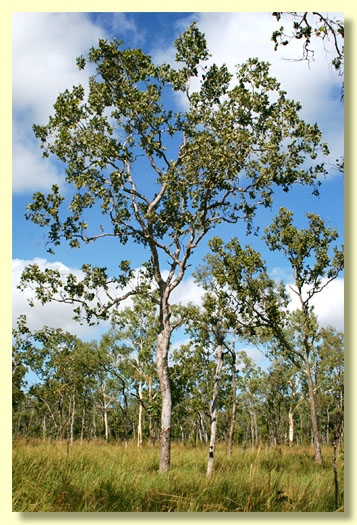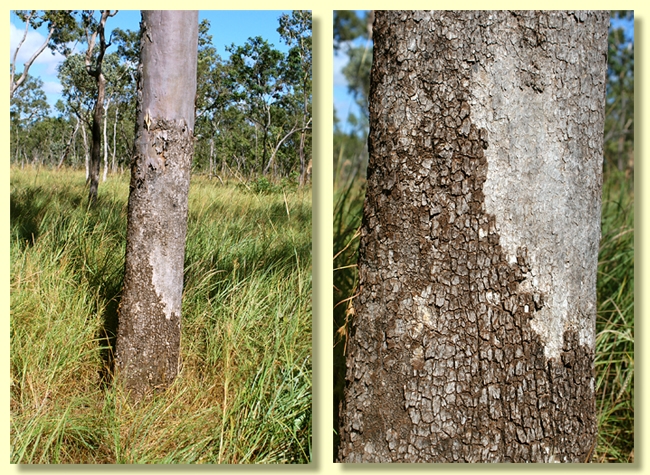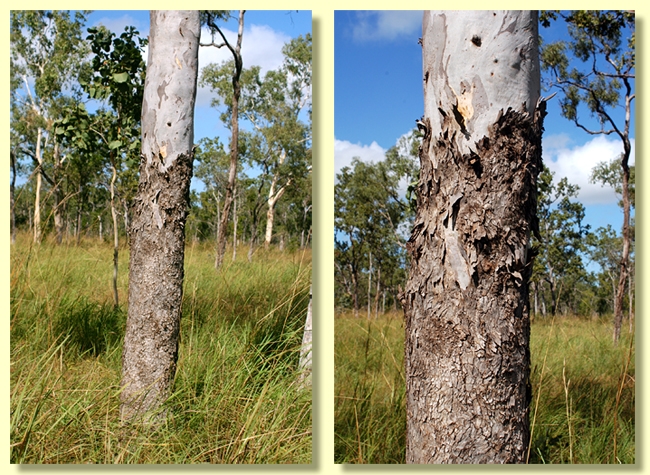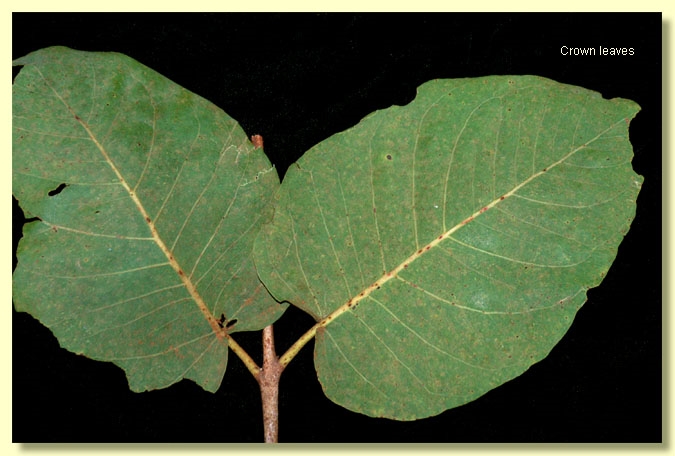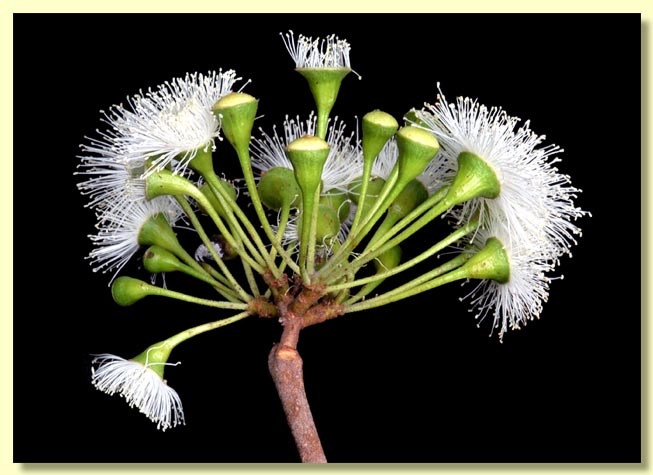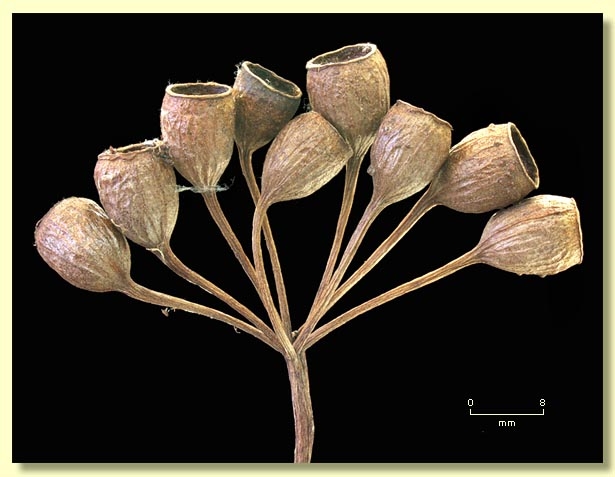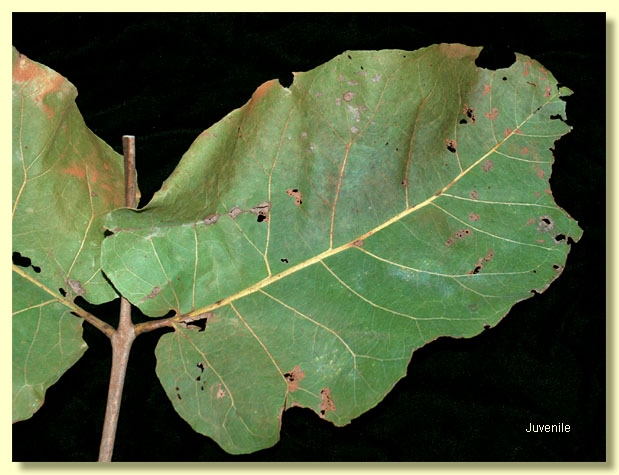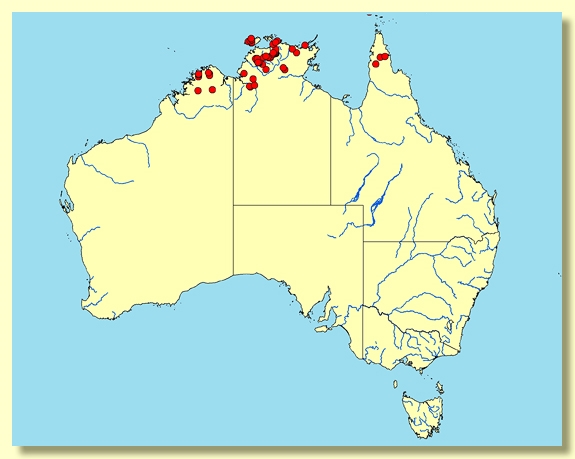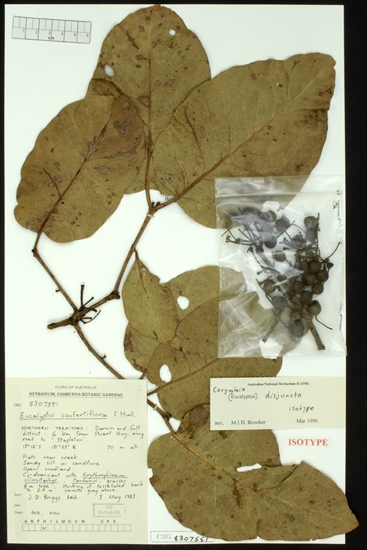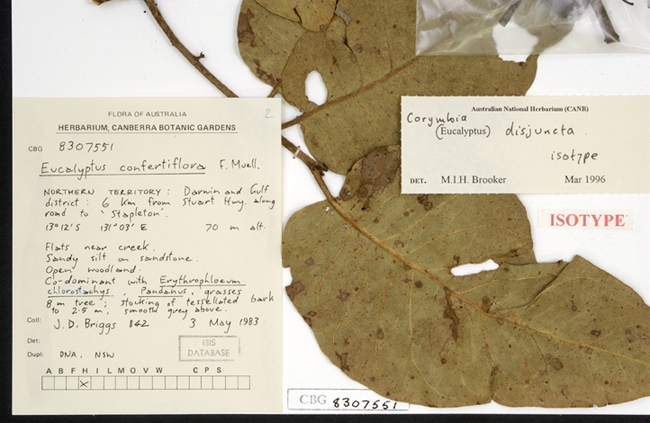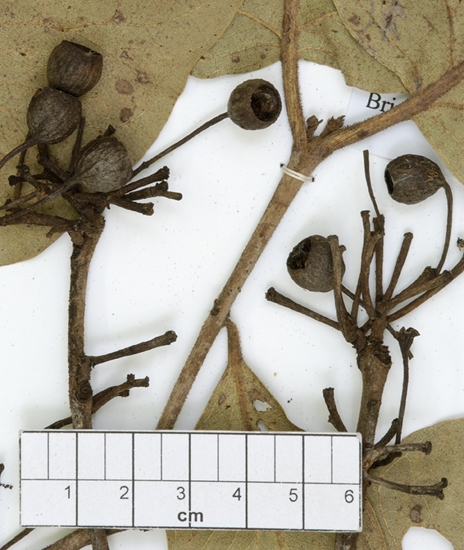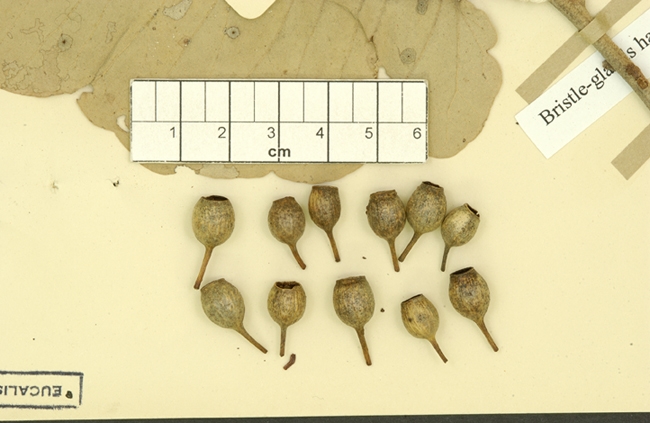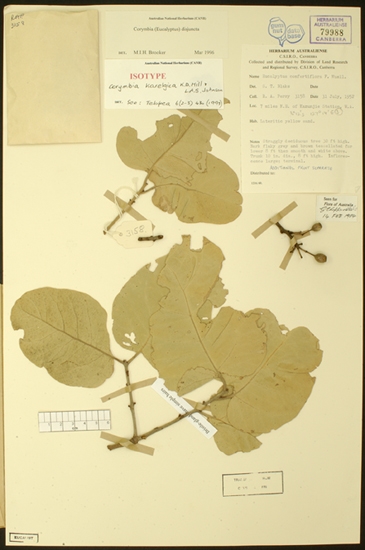Corymbia | Blakearia
Euclid - Online edition
Corymbia disjuncta
Corymbia disjuncta K.D.Hill & L.A.S.Johnson, Telopea 6: 423 (1995).
Tree 15 m tall, deciduous in the late dry season. Forming a lignotuber.
Bark rough, persistent, clearly tessellated and blackish grey for basal part or whole of trunk then abruptly becoming smooth, white to pale grey, shedding in thin flakes.
Younger branchlets setose to scabrid with bristle-glands which in this species lack simple hairs; branchlets lack oil glands in the pith.
Juvenile growth (coppice or field seedlings to 50 cm): stems rounded in cross-section, setose with bristle-glands to sparsely so; juvenile leaves always petiolate, opposite, cordate, 15–35 cm long, 10–23 cm wide, base usually lobed, apex rounded, margin entire, green, dull, setose with bristle-glands.
Crown of intermediate to adult leaves, opposite or with a few alternate, petiolate, petioles 1–3.3(4) cm long; blade predominantly cordate to orbicular or ovate, (6)9–18(25.5) cm long, (4.2)5–12.5(15.6) cm wide, ± undulate, base lobed, rounded or truncate, margin entire or distantly sub-crenulate, apex rounded or broadly pointed, concolorous, dull, green, setose with bristle-glands, side-veins at greater than 45° to midrib, reticulation dense to very dense, intramarginal vein present, oil glands obscure. The new season’s leaf growth is often reddish purple at first.
Inflorescence borne on leafless branchlets before crown replacement, axillary compound, the rhachis consisting of a basal internode ca 0.2–0.7 cm long, a second internode absent or 0.2–1 cm long, and peduncles of variable length within a single inflorescence, 0–1.6(2.4) cm long, buds in 7s or possibly more than 7 per umbel (often difficult to tell especially if peduncles are reduced), strongly pedicellate (pedicels 1.5–3.5 cm). Mature buds pyriform, 0.5–0.8 cm long, 0.4–0.6 cm wide, smooth, scar present (outer operculum shed early), operculum shallowly rounded, sometimes apiculate, stamens inflexed, all fertile, anthers oblong, dorsifixed, versatile, dehiscing by longitudinal slits, style long and straight, stigma tapered, locules 3, the ovules not arranged in distinct vertical rows on the placentae or sometimes arranged in about 5 rows. Flowers creamy white.
Fruit pedicellate (pedicels 1.5–3.5 cm long), cylindrical to barrel-shape to ± urceolate, 0.9–1.7 cm long, 0.7–1.4 cm wide, thin-walled, disc descending vertically, valves 3, enclosed.
Seeds brown, 3–5 mm long, saucer-shaped, smooth, hilum ventral.
Cultivated seedlings (measured at ca node 10): not grown.
Flowering has beeen recorded in August, September, October and November.
A ghost gum of disjunct distribution across the northernmost monsoonal areas of Australia, occurring in the northern and north-western Kimberley region, from Mount Elizabeth and Kalumburu to Ellenbrae and Wyndham, the western and northern lowland areas of the Northern Territory including Dorisvale, Adelaide River, Stapleton, Cobourg Peninsula, Jabiru and Bathurst, Melville and Elcho Islands, and in Queensland on the northern Cape York Peninsula from the Archer River north to Weipa. It also occurs in southern Papua New Guinea. Corymbia disjuncta has a crown of broad, dull, opposite, green, setose to scabrid leaves always with petioles 1–4 cm long, and a regularly tessellated stocking of rough bark on the trunk. The crown is deciduous and the flowers form on the bare branches just below the new season’s leaf growth. The setae on ultimate branchlets and crown leaves in this species may be unadorned with simple hairs or have sparse simple hairs.
C. disjuncta is closely related to three other ghost gum species— C. confertiflora, C. pauciseta and C. dendromerinx. These species, together with a fifth taxon described by Hill & Johnson (1995) as Corymbia karelgica but not recognised in EUCLID, form a group which, prior to 1995, were all included under the name Eucalyptus confertiflora. The division of Eucalyptus confertiflora into several species was made in an attempt to resolve the wide variation in petiole length, leaf shape and size, leaf vestiture type and density, and pedicel length seen across the whole geographic range, i.e. all of monsoonal northern Australia. Some specimens, especially those variable in leaf shape within the one tree crown, may be impossible to determine satisfactorily to species level without resorting to geography and perhaps not even then.
C. disjuncta is distinguished from C. confertiflora by the prominently petiolate and more orbicular crown leaves (petioles 0–0.3(0.5) cm and leaves ovate/cordate in C. confertiflora); and from C. dendromerinx by the comparatively sparse and ± unadorned setae (leaves of C. dendromerinx are very densely setose with the setae much branched). C. pauciseta differs from C. disjuncta in virtually lacking setae on its crown leaves and in having smaller leaves on quite short petioles. Specimens from the sub-coastal islands of the Top End of the Northern Territory matching C. disjuncta in leaf size may be smooth or quite setose and as such show intergradation with C. pauciseta.
Plants from the central Kimberley region described by Hill & Johnson (1995) as C. karelgica differ from C. disjuncta only in being very densely setose with the setae much adorned with simple hairs, and we include C. karelgica, as to type, in synonymy with C. disjuncta. Other similarly setose plants, attributed to C. karelgica by Hill & Johnson (ibid.), but with much shorter petioles and pedicels than C. disjuncta, we believe represent intermediates between C. disjuncta and C. dendromerinx, the latter a species occurring in the south-western Kimberley region.
In the Top End of the Northern Territory C. disjuncta is readily distinguished from two other partly rough-barked ghost gum species, C. polysciada and C. kombolgiensis, both of which have glabrous, lanceolate to broadly lanceolate crown leaves.
In the northern Cape York Peninsula area of Queensland C. disjuncta is easily distinguished from the other ghost gum species present, C. tessellaris and C. papuana, by the setose cordate to orbicular crown leaves compared with the glabrous ± lanceolate leaves of the latter two species. Across its geographic range C. disjuncta is distinguished from the three subspecies of C. grandifolia, all of which are smooth-barked and have glossy crown leaves.
MORE ABOUT CORYMBIA
MORE ABOUT GHOST GUMS
Corymbia disjuncta: Latin disjunctus, separate, referring to the regional distribution pattern.

